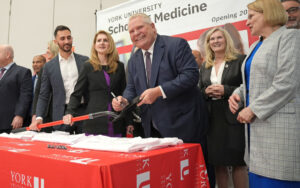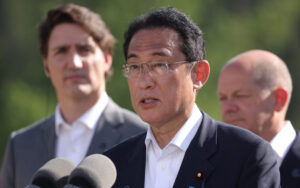
Hamilton city hall where council passed a motion to appoint four representatives to the NPCA Board.
While the new crop of Niagara regional councillors jumped into the NPCA debate with both feet at their inaugural meeting last week, passing a motion to appoint 12 regional councillors to the Niagara Peninsula Conservation Authority (NPCA) Board, their counterparts in Hamilton and Haldimand have said not so fast.
Haldimand passed a motion on Tuesday stating they would be appointing two members to the NPCA Board. Current NPCA board member Rob Shirton was reappointed. He will be joined by Bernie Corbert. Their neighbouring counterparts in Hamilton stated they will be appointing four members – two councillors and two citizens. Hamilton selected city Councillors Brenda Johnson and former MPP Brad Clark. Hamilton council will ratify that recommendation at their Dec. 19 meeting.
Johnson told Hamilton media after she was recommended for appointment at committee meeting; “If anything else there will be some sort of equalization in voting,” said Johnson. “Any time they (Niagara) wanted to approve something, against the City of Hamilton, there were 12 voters saying too bad to be you.”
The knee-jerk reaction by some of the current regime at Niagara’s Regional council appears to have backfired as Niagara has now lost the balance of power. Their representation at the NPCA board is now limited to five members while the total of Hamilton and Haldimand adds up to six members. James Kaspersetz, the NPCA’s current vice-chair said that “both municipalities have appointed great candidates that meet the requirements as laid out in the Auditor General’s report with respect to the skills and qualifications.”
While there are those in Niagara who argue that the NPCA board is no longer in charge and the 12 members the Region appointed last week run the organization, Kaspersetz says the Conservation Authorities Act say otherwise. He says the Act is very clear and that nothing changes until the next Board meeting which is scheduled for Jan. 16.
As for Niagara thinking they can unilaterally appoint 12 people, Kaspersetz says, “Niagara has been told what their number is under the Conservation Authorities Act. That’s the Act that governs the NPCA, not the Municipal Act. We were heavily criticized by the Auditor General in her report for following the Municipal Act too much so we are now following the Conservation Authorities Act very carefully.”
Last week the Ministry of Environment’s assistant deputy minister, Bruce Bateman wrote a letter to all parties involved that clearly stated the NPCA board’s composition should be based upon population according to the updated Conservation Authorities Act and not the 1994 order in council decision that has been deemed null and void. The letter states Niagara gets five members, Hamilton four and Haldimand two.
That letter was in addition to numerous other documents Niagara’s Regional Councillors received prior to their motion on Dec. 6. Those documents included; a legal opinion from both NPCA’s and Niagara Region’s legal counsel, and a letter from the NPCA’s acting CAO, all stating the board membership ratio as five for Niagara, four for Hamilton and two for Haldimand.
Kaspersetz went on to say that it is ironic that the same legislation Niagara used to lower their portion of the levy and dramatically increase Hamilton’s, is the same legislation the new council is conveniently ignoring.
In late November, following in camera Solicitor advice and direction from the Board, former Fort Erie Regional Councillor, and Chair of the NPCA Sandy Annunziata, passed on that same Solicitor opinion to area clerks and Municipal partners. It recommended a selection process area Municipalities were to follow according to a process specifically laid out in the 1994 Order in Council (OIC). By arguing that the OIC was no longer valid, in essence trying to prevent Annunziata from presiding over new board member selection meetings, ultimately it cost Niagara seven board members. “By not liking the appointment process mentioned in the ’94 OIC purely for political reasons, they failed miserably to see the value in any of the OIC; specifically the part that gave Niagara 12 members”. He went on to say that while there are some who insist that the OIC is not valid and has never been used since 1998; “It has. How else has Niagara been able to appoint 12 members for this long? They have used it but a bastardized version of it,” Annunziata said. “What makes the political rhetoric even more absurd and the actions of some Niagara politicians and the media even more frustrating, is that the OIC was supported by two separate and independent legal opinions and could have helped establish a Niagara majority over the short term while the parties, Niagara, Hamilton and Haldimand, worked on an equitable agreement”.
This sudden change in board composition will also have a significant impact on the number of citizen appointees Niagara will have on the NPCA Board. During the election there were many who championed a majority of citizens and not politicians be appointed to the NPCA board. However, Dr. Andrew Sancton from the University of Western Ontario who is conducting an independent governance review of the Region, has stated there still needs to be political representation.
Sancton states in his report; “… between one-third and one-half of Niagara appointees should be ordinary citizens, the remainder being regional councillors.” In addition, some citizens and councillors have said politicians on the NPCA board would make decisions based on what is in the best interest of their respective municipalities and not the environment. However the Conservation Authorities Act does state in Section 3; “The representatives so appointed have authority to vote and generally act on behalf of their respective municipalities at the meeting.”
Given that Niagara is now down to five members, that doesn’t leave a lot of room for citizen appointees. It also begs the question of which municipalities those citizens will come from.




















